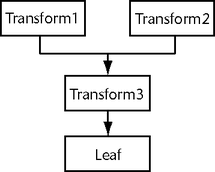Transform nodes can have multiple child nodes—the child nodes are “grouped” beneath the transformation node. Node grouping allows them to share transformation information and be treated as a unit.
Transform nodes and shape nodes can also have multiple parent nodes—these nodes are “instanced”. Instancing can be useful to reduce the amount of geometry for a model. For example, if you model a tree, you could create a thousand unique leaves to populate the tree. This would make for a very data heavy model, since each leaf would have it’s own transformation nodes, shape nodes, and NURBS or polygon data. Instead, you can create a single leaf and instance it a thousand times to create a thousand identical leaves and position them independently around the branches of the tree. This way the shape node and NURBS or polygon data is shared.

This DAG hierarchy has three transform nodes (Transform1, Transform2, Transform3) and one shape node (Leaf). This DAG hierarchy would cause two leaves to be displayed since Transform3 and the Leaf is instanced (it has two parents).